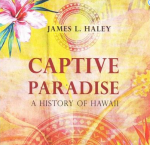This is part four of a series of articles I’ve been drafting for my students in Hawai’i Politics and other courses. Part one deals with rail and other issues andpart two with race and the Democratic machine. The third installment looked at the psychology of development. This fourth installment examines the problems with the transmission of history in books and schools.
In the recently-published book Captive Paradise by James L. Haley, the author essentially brags that he consulted no Hawaiian historians or Hawaiian language sources because doing so would simply be “political correctness.” He claims that English language sources are adequate.
An independent scholar published by St. Martin’s press (a major publishing house), Haley launched another assault on Hawaiʻi’s history from outside, along with Julia Flynn Siler’s Lost Kingdom. Lost Kingdom was not as blatantly anti-historiography, but contained mistakes, which the author admitted (confusing Liholiho and Alexander Liholiho). One problem was that after four years of research, the author and her research assistant failed to even come across the argument that Hawaiʻi was illegally annexed. It makes one wonder what universe they live in (certainly not the umiverse;). As Makana Risser Chai wrote on Amazon and the umiverse in her review of Siler’s book:
The author gives two sentences to the petitions against annexation sent by tens of thousands of Hawaiians. She makes no mention that as a result of this and other opposition, the treaty of annexation was defeated on February 27, 1898, when only 46 senators voted in favor. She states (284), “a joint resolution on annexation passed Congress with a simple majority,” without noting that annexation, under the U. S. Constitution, cannot take place by resolution. It was a procedural move by Republicans who could not get the two-thirds majority they needed for a treaty.
The worst failing of this book is that it makes the fascinating history of Hawai`i a dry, boring read. If you want to read an accurate, entertaining introduction to this particular part of Hawaiian history, I highly recommend Sarah Vowell’s Unfamiliar Fishes.
Locally, things are not much better, as I’ve repeatedly written. Think of the process of becoming a Hawaiian history teacher in the public schools: you have to pass the Praxis test, which is 40% history (no Hawaiian history) and 60% a wide variety of other social sciences. The chances that someone will know all this and have a deep understanding of Hawaiian history is quite unlikely, though by no means impossible. At the very least, it would take time – a lot of it. And given that the average teacher leaves the profession within five years, those left with a deep understanding of Hawaiian history are quite rare indeed. According to a DOE teacher I know who reviewed the new version of their textbook, the book reflects little, or none of the scholarship from the past 25 years.
This trickles up to politicians with very little understanding of Hawaiʻi’s history. For this reason I support the effort to train politicians in Hawaiian culture. I’ve also suggested to historians that a committee be formed that would give a stamp of credibility to works on Hawaiian history. This would be voluntary, but not having the stamp could eventually throw such works into question



Shame on St. Martin’s. Speaking of problems in the transmission of history, I’m working on a group project in my graduate Inter-Group Conflict Transformation course in Cambridge right now on the Military Occupation of Hawai`i. I’m finding it extremely difficult to pinpoint how and when the U.S. military acquired these lands (to include Kahoolawe). I went on an historical tour of Hickam a few years ago and was told that the land had been loaned to the Army Air Corps by the king and had previously contained taro patches and houses of ill repute before that, but I can find nothing to back that up…I somehow doubt 25% of the islands just fell into military hands and wonder how these “officially” became federal property.
LikeLike
first source that comes to mind: Native Hawaiian Rights Handbook (MacKenzie, 1991) states that the early bases were “acquired” (seized) by executive order of McKinley around 1901 – Ft. Shafter and Schofield for sure, maybe a couple of others – I thought Hickham was a little later, not earlier (so not the King) – the King did transfer Pearl Harbor as a condition of the Bayonet Constitution – that may be PH-Hickham joint base area..
LikeLike
Aloha from Kona I may be of help with your project, and may have the answers you seek
LikeLike
I think farming such a committee would be difficult but worthwhile. And it would be incredibly useful for teachers and students in the public and private education systems. Because the social and economic elite send their children to private schools, it is a matter of public concern that none of the schools systematically, as a matter of design, do the complexity of late 19th and 20th century history of Hawaii justice. And I do not think a single, univocal textbook is the answer, but rather a community-developed constructivist approach centered not only on the most recent historiography but also on materials designed so that students become critical thinkers themselves through examination of primary sources. The question is, how best to demystify occupation?:)
LikeLike
these are difficult issues… a “univocal” textbook is not a final answer (itʻs immediately out of date for one thing), but itʻs a huge step in the right direction. Youʻre right, I think private schools, on the whole are doing a worse job than public schools – some donʻt require or offer Hawaiian history at all. Occupation is another question – I just use a chart comparing the two views as a start…
LikeLike